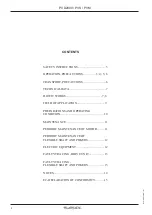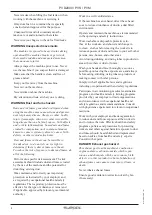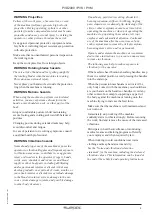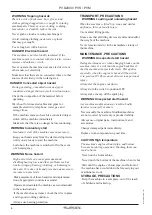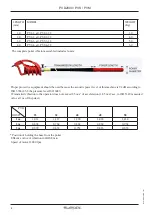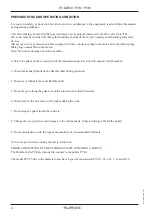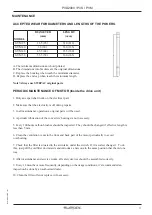
4
PVD2000 / PVS / PVM
D
ok
: 101503A
-GB 1931
Never smoke when filling the fuel tank or when
working with the machine or servicing it.
Only store fuel in a container that is specially
constructed and approved for the purpose.
Consumed fuel and oil containers must be
taken care of and returned to the retailer.
Never use your fingers to check for fluid leaks.
WARNING Unexpected movements
The machine is exposed to heavy strains during
operation.If the machine breaks or gets stuck,
there maybe sudden and unexpected movemen
that can cause injuries.
Always inspect the machine prior to use. Never
use the machine if you suspect that it is damaged.
Make sure that the handle is clean and free of
grease and oil.
Keep your feet away from the machine.
Never sit on the machine.
Never strike or abuse the machine.
Pay attention and look at what you are doing.
WARNING Dust and fume hazard
Dusts and /or fumes generated or dispersed when
using the machine may cause serious and perma
-
nent respiratory disease, illness, or other bodily
injury (forexample, silicosis or other irreversible
lung disease that can be fatal, cancer, birth defects,
and /or skin inflammation). Some dusts and fumes
created by compaction work contain substances
known to cause respiratory disease, cancer, birth
defects, or other reproductive harm.
Dust and fumes in the air can be invisible to
the naked eye, so do not rely on eye sight to
determine if there is dust or fumes are the air.
To reduce the risk of exposure to dust and fumes, do
all of the following:
Perform site-specific risk assessment. The risk
assessment should include dust and fumes created
by the use of the machine and the potential for
disturbing existing dust.
Wear, maintain and correctly use respiratory
protection as instructed by your employer and
as required by occupational health and safety
regulations. Ther espiratory protection must be
effective for the type of substance at issue (and
if applicable, approved by relevant governmental
authority).
Work in a well ventilated area.
If the machine has an exhaust, direct the exhaust
so as to reduce disturbance of dustin a dust filled
environment.
Operate and maintain the machine as recommended
in the operating and safety instructions.
Wear washable or disposable protective clo-
thes at the worksite, and shower and change in
to clean clothes before leaving the work site to
reduce exposure of dust and fumes to your self, other
persons, cars, homes, and other areas.
Avoid eating,drinking, and using tobacco products in
areas where there is dust or fumes.
Wash your hands and face thoroughly as soon as
possible upon leaving the exposure area,and always
before eating, drinking, using tobacco products,or
making contact with other persons.
Comply with all applicable laws and regultions,
including occupational health and safety regulations.
Participate in air monitoring, medical examination
programs, and health and safety training programs
provided by your employer or trade organizations
and in accordance with occupational health and
safety regulations and recommendations. Consult
with physicians experienced in relevant occupational
medicine.
Work with your employer and trade organization
to reduce dust and fume exposure at the work site
and to reduce the risks. Effective health and safety
programs, policies and procedures for protecting
workers and others against harmful exposure to dust
and fumes should be established and mplemented
based on advice from health and safety experts.
Consult with experts.
DANGER Exhaust gas hazard
The exhaust gas from the machine’s combustion
engine contains carbon monoxide which is poi
-
sonous, and chemicals which cause cancer, birth
defects, or other reproductive harm. Inhalation of
exhaust fumes can cause serious injury, illness, or
death.
Never inhale exhaust fumes.
Ensure good ventilation (extraction of air by fan
if necessary).


